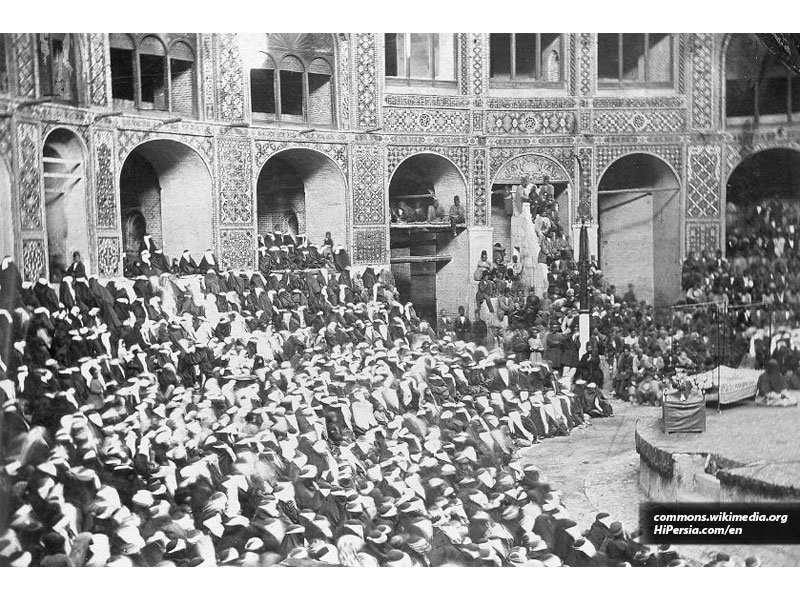



Ta'zieh is an Iranian mourning ceremony in which a theatrical representation of the events of Karbala is performed. this event takes place in the month of Muharram for the martyrdom of the third Imam of the Shi'ite faith, Imam Husain and is a sacred and prohibited month, acts of violence are usually convicted harsher.
Ta'zieh is a traditional Shi'ite-Iranian ritual that is usually portrayed in the Tragedy of Karbala and the martyrdom of Imam Husain (AS) and his family. Ta'zieh means comfort, condolence, or expression of pain. It comes from the roots of the word Aza (عزا), which means mourning. Ta'zieh is a religious performance inspired by the incidents of the day of Ashura and the event of Karbala to mourn the martyrdom of Imam Hussein (AS) and 72 of his companions in Karbala.

The history of Ta'zieh dates back to three thousand years ago, and the performance of Sog-e Siavash is about the death of the Iranian national hero. With the arrival of Islam in Iran, Ta'zieh was formed during the Āl-e Buye period by Mu'izz al-Dawla. However, it reached its peak during the Qajar era.
During the Safavid period and the peak of Shi'ism, the ceremonies of the Ta'ziyeh took shape. The fundamental changes occurred during the Qajar era, especially during the reign of Nasir al-Din Shah in Ta'zieh performance. During the Nasir al-Din Shah era, it became known as the Golden Age of Ta'zieh performance. The Qajar rulers benefited from the magnificent performances of Ta'zieh to obtain symbolic legitimacy among the people.
Tekyeh Dowlat was built on the Naser al-Din Shah's order for holding the ceremonies of Ta'zieh, as well as the mourning of Muharram. The idea of building the Tekyeh Dowlat came to him when he traveled to England and saw the theater halls.
The tyrannized society of the Qajar era sympathized with the oppressed characters of the Ashura event. Therefore, the lower classes of society during the Qajar period enjoyed Ta'zieh. With the rise of the Pahlavi dynasty, Reza Shah began to oppose the ritual of Ta'zieh for the expansion of modernity in society. So, the performances of Ta'zieh were driven to the villages and continued to be sparse.

Like other shows or theater, Ta'zieh has several elements. Each character of Ta'zieh has certain titles. The scenario or plan of the Tazieh is written by Maqtal Nevis. The Maqtal is the historical monographs and narrations about the murder or martyrdom of a well-known character in history. The Characters of Ta'zieh are divided into two groups: good and evil roles. Rajaz-Khani or bragging is said to be a situation in which the Imam's family and opponents talk about their honor and descent. The players who have the role of Imam Hussein (AS) and his companions are called Movafeghkhan, and the enemies, called Mokhalefkhan.

The choice of the dress colors of these two groups is based on symbolic and character-based reasons. The green represents the symbol of purity, and the red shows the symbol of blood. So, Movafeghkhan plays with the green symbols and Mokhalefkhan with the red symbols. As well as, green is a symbol of peacefulness in Shahnameh (a long epic poem written by the Persian poet Ferdowsi), and the tent of Rustam (a legendary hero in Shahnameh and Iranian mythology) is green. Therefore, it seems that the choice of colors, although a combination of Iranian-Islamic art, is rooted in the mythological history of Iran. The yellow in Shahnameh symbolizes fear and disappointment. Since the character of Hur bin Yazid was dressed in yellow color as if it were a symbol of fear and hesitation. Hur bin Yazid had been against Imam Hussein (AS) but later repented. The black is also known as the symbol of panic and grief in Ta'zieh.


Grand Bazaar of Tehran, the best place to see the mourning ceremony of Muharram
The Grand Bazaar of Tehran is one of the oldest parts of the city, where the mourning ceremony of Muharram is held annually. Since the Qajar, the mourning ceremony of Muharram has been held in the Tekyeh Dowlat until now. This ceremony has always been very enthusiastic in this area of Tehran. Mourning in this area is still traditionally held, and this has caused a different sense of experience at this point in the city.






“Oh! Squander not this breath that Heaven hath lent thee, Nor make too sure another breath to borrow!’” Khayam